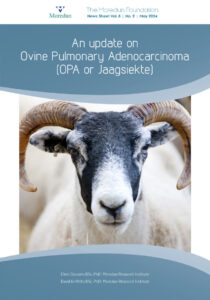Log in
or become a member
to see this content
Publication Date: 16/05/2024

In this factsheet:
Ovine Pulmonary Adenocarcinoma (OPA) is a specific and infectious lung cancer in sheep, caused by the jaagsiekte sheep retrovirus (JSRV). The virus spreads through the air via inhalation or direct contact with infected respiratory secretions. The typical symptoms of OPA include difficulty in breathing, often accompanied by significant weight loss. A distinctive feature of OPA is the excessive production of fluid in the lungs, which can manifest as a watery discharge from the nose in some affected animals.
The clinical signs of OPA can take several years to develop after a sheep is infected with the virus. This long incubation period means that the number of infected animals in a flock can be much higher than the number showing clinical signs of the disease. Currently, there is no effective treatment for OPA. Additionally, no strong evidence exists to suggest breed differences in susceptibility to the disease.
OPA is commonly introduced into new flocks through the purchase of apparently healthy animals that are carriers of the virus. To manage and control the spread of OPA, it is essential to isolate animals suspected of being affected and consult a veterinarian. Post-mortem examination of the lungs is recommended to confirm the diagnosis.
Early detection of OPA can be challenging, but transthoracic ultrasound scanning is a valuable tool for identifying sheep with small tumours before clinical symptoms appear. However, reliable tests to detect JSRV infection in sheep before tumour development are not yet available and remain an active area of research.
This factsheet provides independent, impartial and science-informed responses to common questions related to Ovine Pulmonary Adenocarcinoma (OPA). These include how to know if your has OPA, how to treat and control it (including the benefits of scanning), and how likely is it to spread if your neighbour’s sheep have it. The factsheet also provides a brief update on the latest research on an OPA diagnostic test to detect OPA before appearance of clinical disease.
